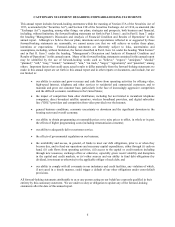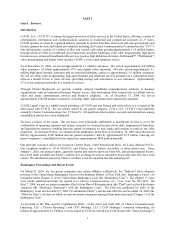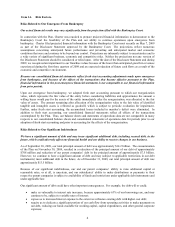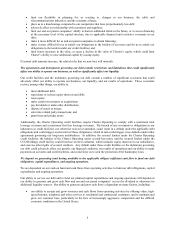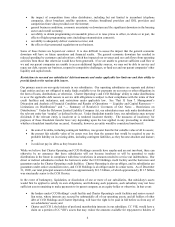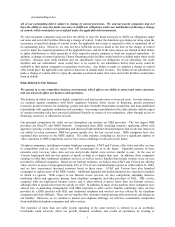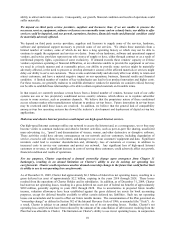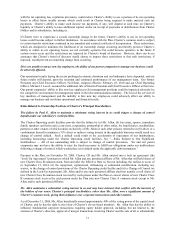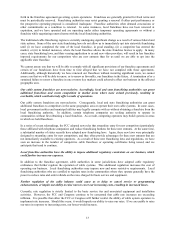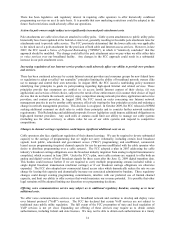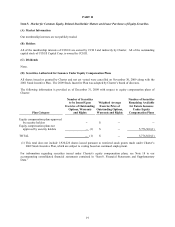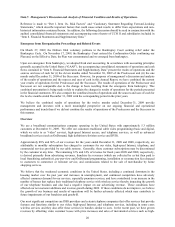Charter 2009 Annual Report Download - page 13
Download and view the complete annual report
Please find page 13 of the 2009 Charter annual report below. You can navigate through the pages in the report by either clicking on the pages listed below, or by using the keyword search tool below to find specific information within the annual report.
10
ability to attract and retain customers. Consequently, our growth, financial condition and results of operations could
suffer materially.
We depend on third party service providers, suppliers and licensors; thus, if we are unable to procure the
necessary services, equipment, software or licenses on reasonable terms and on a timely basis, our ability to offer
services could be impaired, and our growth, operations, business, financial results and financial condition could
be materially adversely affected.
We depend on third party service providers, suppliers and licensors to supply some of the services, hardware,
software and operational support necessary to provide some of our services. We obtain these materials from a
limited number of vendors, some of which do not have a long operating history or which may not be able to
continue to supply the equipment and services we desire. Some of our hardware, software and operational support
vendors, and service providers represent our sole source of supply or have, either through contract or as a result of
intellectual property rights, a position of some exclusivity. If demand exceeds these vendors’ capacity or if these
vendors experience operating or financial difficulties, or are otherwise unable to provide the equipment or services
we need in a timely manner and at reasonable prices, our ability to provide some services might be materially
adversely affected, or the need to procure or develop alternative sources of the affected materials or services might
delay our ability to serve our customers. These events could materially and adversely affect our ability to retain and
attract customers, and have a material negative impact on our operations, business, financial results and financial
condition. A limited number of vendors of key technologies can lead to less product innovation and higher costs.
For these reasons, we generally endeavor to establish alternative vendors for materials we consider critical, but may
not be able to establish these relationships or be able to obtain required materials on favorable terms.
In that regard, we currently purchase set-top boxes from a limited number of vendors, because each of our cable
systems use one or two proprietary conditional access security schemes, which allows us to regulate subscriber
access to some services, such as premium channels. We believe that the proprietary nature of these conditional
access schemes makes other manufacturers reluctant to produce set-top boxes. Future innovation in set-top boxes
may be restricted until these issues are resolved. In addition, we believe that the general lack of compatibility
among set-top box operating systems has slowed the industry’ s development and deployment of digital set-top box
applications.
Malicious and abusive Internet practices could impair our high-speed Internet services.
Our high-speed Internet customers utilize our network to access the Internet and, as a consequence, we or they may
become victim to common malicious and abusive Internet activities, such as peer-to-peer file sharing, unsolicited
mass advertising (i.e., “spam”) and dissemination of viruses, worms, and other destructive or disruptive software.
These activities could have adverse consequences on our network and our customers, including degradation of
service, excessive call volume to call centers, and damage to our or our customers' equipment and data. Significant
incidents could lead to customer dissatisfaction and, ultimately, loss of customers or revenue, in addition to
increased costs to service our customers and protect our network. Any significant loss of high-speed Internet
customers or revenue, or significant increase in costs of serving those customers, could adversely affect our growth,
financial condition and results of operations.
For tax purposes, Charter experienced a deemed ownership change upon emergence from Chapter 11
bankruptcy, resulting in an annual limitation on Charter’s ability to use its existing net operating loss
carryforwards. Charter could experience another deemed ownership change in the future that could further limit
its ability to use its net operating loss carryforwards.
As of December 31, 2009, Charter had approximately $6.3 billion of federal tax net operating losses, resulting in a
gross deferred tax asset of approximately $2.2 billion, expiring in the years 2014 through 2028. These losses
resulted from the operations of Charter Holdco and its subsidiaries. In addition, as of December 31, 2009, Charter
had state tax net operating losses, resulting in a gross deferred tax asset (net of federal tax benefit) of approximately
$209 million, generally expiring in years 2010 through 2028. Due to uncertainties in projected future taxable
income, valuation allowances have been established against the gross deferred tax assets for book accounting
purposes, except for deferred benefits available to offset certain deferred tax liabilities. Such tax net operating
losses can accumulate and be used to offset our future taxable income. The consummation of the Plan generated an
“ownership change” as defined in Section 382 of the Internal Revenue Code of 1986, as amended (the “Code”). As
a result, Charter is subject to an annual limitation on the use of its net operating losses. Further, Charter’ s net
operating loss carryforwards have been reduced by the amount of the cancellation of debt income resulting from the
Plan that was allocable to Charter. The limitation on Charter’ s ability to use its net operating losses, in conjunction


